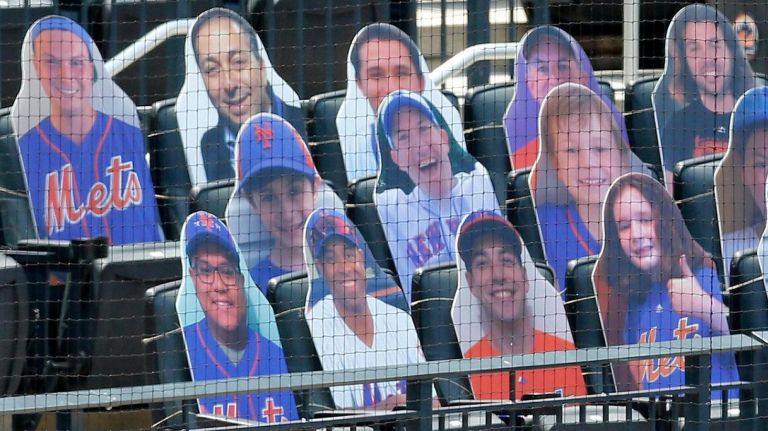|
Cardboard spectators stared vapidly from behind home plate, their expressions never changing as the Mets and Yankees committed something akin to baseball.
This was the ambiance at New Shea Saturday night as Major League Baseball introduced Covid-Ball, a makeshift version of the great American pastime, or what used to be. Cruel boss that I am, I assigned myself to stick it out as a preview, or warning, of what this truncated season will be, if it lasts its threatened 60 games. (Some wary big names have already dropped out for this season; others are trying to come back from a Covid attack. To be continued.) This was only an exhibition, spring training in mid-July, and there was to be another one at Yankee Stadium Sunday evening before the “season” opens late in the week. I will tell you up front that my biggest thrill of the night was seeing the aerial view of Queens, my home borough – the globe in the park, a glimpse of the wonderful Queens Museum, the No. 7 elevated train gliding through the neighborhood, as sweet as a gondola through Venice. Oh, my! I am so homesick for Queens! I thought of the joys within a mile or two of this sweet spot – my friends and the heroes at Mama’s deli on 104th St., other friends at the New York Times plant, just to the east, the food and the crowds in downtown Flushing, the Indian food in Jackson Heights, and so on. I miss all these at least as much as baseball. There was a strange hybrid form of baseball taking place in New Shea. Yankee manager Aaron Boone was moving his jaws inside his soft gray mask, either chewing something or talking a lot. The first home-plate ump (they mysteriously rotated during the game) had some kind of plexiglass shield inside his mask, to ward off virulent Trumpian microbes. I was mostly watching the Mets’ broadcast, with good old Ron and good old Keith two yards apart in one booth and good old Gary in a separate booth, but their familiarity and friendship came through. Welcome to this strange new world. Later I switched to the Yankee broadcast and realized Michael Kay and the others were not in Queens but were commenting off the same video we were seeing. Not sure how that will work out during the season. Early in the game I learned that the Toronto Blue Jays will not be able to play in that lovely city this “season,” for fear of being contaminated by the virus the viciously bumbling Trump “government” and block-headed Sunbelt Republican governors have allowed to rage. I don’t blame the more enlightened Canadian government – but a few days before the season opener? The Jays will apparently play in Buffalo, creating all kinds of logistical horrors for anybody in Ontario with Blue Jay business. The highlight of Saturday’s exhibition was Clint Frazier, the strong-minded Yankee outfielder who plans to wear a kerchief-type mask during games, including at bat. Does a mask impede a batter’s reaction to a fastball, up and in? Maybe. But Frazier unloaded a 450-foot homer into the empty upper deck – (Sound of summer: Michael Kay: “SEE-ya!”) -- and some teammates in the dugout flashed masks in tribute to Frazier. I obsessed about those cardboard fans behind home plate. The absence of real people takes away one of the peripheral joys of watching a game – demonstrative or even annoying fans, the occasional celebrity, and, yes, I admit, women in summer garb. Will these faux fans become part of lore? Will they be rotated, replaced by new faces during the “season?” Just asking. Finally, there was the recorded crowd noise, an apparently steady hum. No pro-Met chants, no anti-Yankee jibes, just background, like the roar of the sea, I caught the last inning on the Mets’ radio broadcast, where good old Howie was speculating that the home-team genies in the control room were raising the sound a bit when the Mets were rallying. I stuck it out because I had assigned myself to “cover” the event. But I wondered about the reaction of my pal, Jerry Rosenthal, one-time all-conference shortstop at Hofstra, two-year Milwaukee Brave farmhand, and now lifetime baseball purist and authority. How did Jerry like the ersatz game? He texted: “Watched one inning of the game. I am now watching ‘The Maltese Falcon” for about the 25th time. That should tell you something!” Yes, it does. Play “ball.” 7/19/2020 11:00:27 am
A lovely reverie about missing Queens, George. Didn't know about a Mama's Deli on your 104th Street but imagine my thrill when I discovered a Horn and Hardart's Automat once stood at 104th Street/Broadway in Manhattan (long before I moved nearby in 1976). BTW Yankee manager is Aaron Boone not Bob Boone, but more important like Jerry I was watching "Maltese Falcon" last night too and then "High Sierra" (not to be confused with Ruben Sierra).
George Vecsey
7/19/2020 11:28:32 am
Lee, at least I didn't call him "Ray." That could happen. It's fixed now.
Marty Appel
7/19/2020 12:01:02 pm
As a former Maspeth guy, I too enjoyed the Queens shots....and I miss Sunny's Chinese on Queens Blvd, where I was introduced to the cuisine.
Curt Block
7/19/2020 05:00:26 pm
George,
George Vecsey
7/19/2020 05:11:43 pm
Curt: Regards to my Hofstra classmate and point guard who produced several buzzer-beater victories against good teams back in the day, I was keeping score.
Altenir Silva
7/20/2020 08:01:14 am
Dear George: It will be an estrange season for baseball. I saw the two home runs by Aaron Judge, while the TV was showing the stadium empty. This experience was like seeing an apocalyptic movie. Very weird.
George Vecsey
7/20/2020 10:50:44 am
Altenir: 7/20/2020 06:29:34 pm
I just don’t get it. What is so difficult about understanding safety?
George
7/20/2020 11:06:43 pm
Alan; also, do not put beans up your nose. Comments are closed.
|
Categories
All
|










